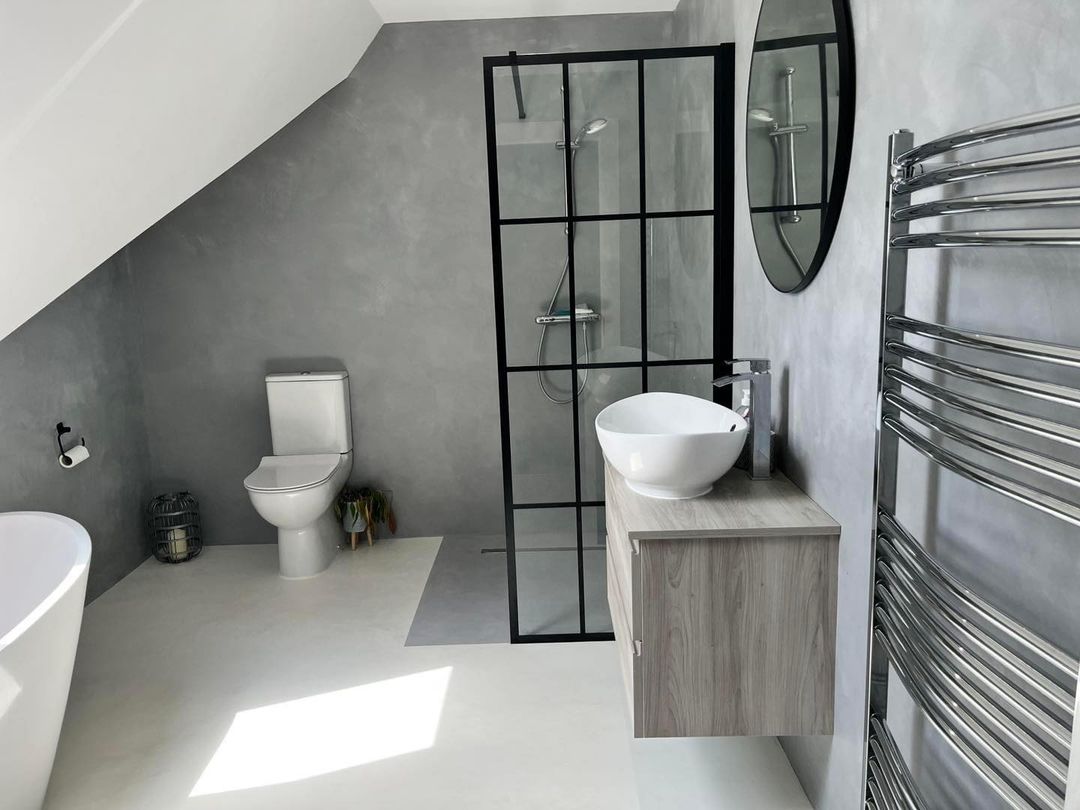Where Can You Apply Microcement?

Share
- Bathroom
- Eco-friendly
- Flooring
- Home Renovation
- Kitchen
- Microcement
- Microcement Application
- Microcement Floor
- Microcemento
- Property Developement
- Stairs
Not many people know just how many surfaces can Microcement be applied on. This seamless and durable finish is not only beautiful to look at, but it also offers a practical solution who want to create a cohesive feel and need a uniform look across multiple surfaces. As it offers a water-resistant finish, it can be applied to almost any space where most decorative materials would be off-limits, such as areas exposed to high temperature and humidity.
So which are the most popular applications of Microcement around the home?
-
Floors
Choosing a seamless, and customisable finish for flooring that provides a continuous look without any joints, is becoming more and more popular as open-space solutions are on the rise for residential homes, and commercial developments.
Microcement provides an aesthetic and practical solution that is bespoke and made to fit any project, and offers plenty of choices for those who wish to customise a finish their own way.
-
Walls
Microcement is known for the concrete-like finish that can be created with it, which tends to be popular for modern and industrial-style interiors, especially in commercial buildings. It is a material, however, which can be pushed much further than that. When it comes to intricate patterns, such as a marble finish, microcement is a great option for feature walls.
Depending on where the finish will be applied, we recommend including the anti-crack system. It is optional areas where the Microcement is not in direct contact with water, but it is a must to include for any project concerning flooring and wet room areas.
-
Bathrooms
If you ever saw a photo of a seamless, modern bathroom, you can imagine what Microcement looks like in these spaces. A lot of people compare it to the Tadelakt finish, but when it comes to technical details, the two are not the same.
Microcement is a meticulously developed material that can ensure a water-resistant and durable finish, even with its relatively thin coating. It includes an anti-crack system, and a resin-protecting coat, which ensures the water can’t penetrate and damage the surface. This makes Microcement a practical and aesthetically pleasing material, that can be used on multiple surfaces across the bathroom, from the shower area to the worktops and cabinets.
If you are interested in having Microcement installed in your bathroom, be sure to ask for a sample from your applicator, without sample kits!
-
Kitchens
When it comes to the kitchen, applying Microcement doesn’t have to stop at the floors and walls, it’s a great idea to have it installed on the worktops, shelves and splashbacks, for a continuous finish!
It provides a seamless and easy-to-clean surface on countertops and worktops, with it bespoke colours and protectors so your kitchen can be practical and beautiful at the same time.
-
Furniture and Custom Designs
When used on larger surfaces in the home, some people feel inspired to have a matching finish on various elements around the home, such as joinery or shelves. Due to the nature of Microcement, as a material that is applied from a container directly on the surface, it offers the option to create custom solutions for any surface you’d like to cover.
Some of the most popular ones include staircases and cabinetry with shelves and countertops. It’s a wonderful option for those who want their home interiors to feel cohesive and modern, to provide the perfect backdrop for their day-to-day lives.
If you are interested in how Microcement looks when it's being applied, check the full application video for our Continuo Microcement here!
What are the Advantages of Choosing Microcement for Different Surfaces?
There are a few reasons why Microcement is becoming more and more popular in the world of Interior Design, and here are just a few!
The Seamless Finish: Microcement creates a smooth, joint-free surface that is easy to clean and maintain.
The Durability: It is resistant to wear, impact, and chemical damage, making it suitable for different surfaces.
The Versatility: It can be applied to various surfaces and tailored to different textures and colours.
The Water-Resistance: It is ideal for wet areas like bathrooms, floors and kitchens when properly sealed.
The Quick Installation Process: It can be applied over existing surfaces, reducing the need for extensive demolition and speeding up renovation projects.
Conclusion
Due to the nature of microcement, it can be a practical and versatile product to choose for many different surfaces for a seamless, bespoke finish.
Its adaptability ensures it meets aesthetic and functional requirements, which is what made it popular for different areas in the home, from flooring to worktops, and showers.
